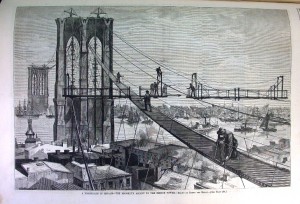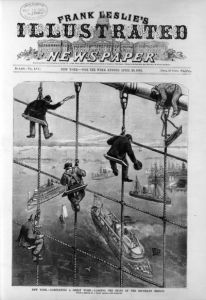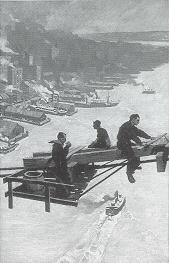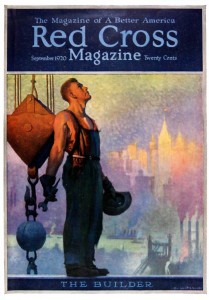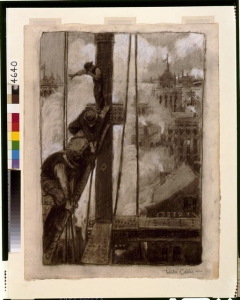
Thornton Oakley (1881-1953) | [Three ironworkers on girder with steam and rooftops in background, New York City] 1904 |Unused illustration probably created for Century Magazine | Charcoal and Chinese White on paper | Cabinet of American Illustration, Prints and Photographs Division, Library of Congress; gift of Jay Last
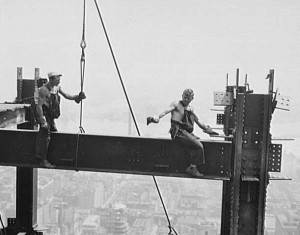 Lewis W. Hine (1874-1940); Connecting the beams (1931); NYPL Digital Gallery, Image ID: 79852
Lewis W. Hine (1874-1940); Connecting the beams (1931); NYPL Digital Gallery, Image ID: 79852
But the reality is that as curtain wall tall buildings began to rise above American city skylines in the late 19th century, various chroniclers of American life began to make images, write poetry and stories focused on the men who walked the beams and spent their days working among the clouds. Recording this startling new phenomena in illustration or by photograph allowed earth-bound viewers of construction an opportunity to safely witness worker’s precarious perches and the apparently death defying feat of working and walking along the beams that make up a tall building’s framework. As Walt Whitman romantically wrote in his 1900 poem “Mannahatta” from Leaves of Grass: “Numberless crowded streets—high growths of iron, slender, strong, light, splendidly uprising toward clear skies;”.
The earliest illustrations of workmen in the sky of which I am aware, were created as a wood engraved illustrations recording the building of the Brooklyn Bridge, the first steel cable suspension bridge. In 1877 Harper’s Weekly produced a full page illustration of this bridge’s construction. As the process of building the bridge rolled to conclusion, the April 28, 1883 cover illustration for Frank Leslie’s Illustrated Newspaper
Harper’s Weekly, 1877 Frank Leslie’s Illustrated Newspaper (April 28, 1883)
In July of 1904 illustrator Thornton Oakley created his charcoal and Chinese white image of Three Iron workers on a girder that is shown at the beginning of this posting. It is thought the drawing was created for but not used by the Century magazine. Whatever building the image was meant to depict, it is in fact remarkably similar to Lewis Hine’s photograph taken some 27 years later even if the view into the picture is from a different angle. Oakley would revisit illustrating construction in 1909 when he produced paintings of men working on the construction of a bridge for a 1909 article in Harper’s Monthly that is reminiscent of the 1877 Harper’s Weekly illustration seen above.
Thornton Oakley (1881-1953); The Weaving of the Bridge, 1909; Illustration for “The Weaving of the Bridge” by Edward Hungerford in Harper’s Monthly (July 1909): 221-232; Oil on canvas; Private Collection
In 1911, John Sloan also created an illustration called Salute of a construction worker poised on a girder tipping his hat to the woman and child seen through a window of a building across from the construction site.
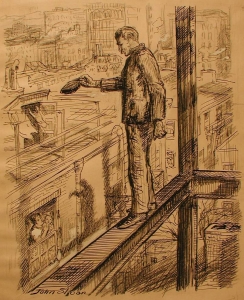 John Sloan (1871-1951); Salute, 1911; Illustration thought to be for the New York Call*; Ink and Chinese white on paper; Delaware Art Museum, Gift of Helen Farr Sloan, DAM 1991-85
John Sloan (1871-1951); Salute, 1911; Illustration thought to be for the New York Call*; Ink and Chinese white on paper; Delaware Art Museum, Gift of Helen Farr Sloan, DAM 1991-85
And in 1912, poet Carl Sandburg wrote and published his poem “Skyscraper”** about the tall building structures of Chicago and the way the construction workers toil and sweat over their dangerous work and how all of their efforts remain forever part of the buildings they leave behind.
Hour by hour the girders play as ribs and reach out and
hold together the stone walls and floors.
. . .
(One man fell from a girder and broke his neck at the
end of a straight plunge–he is here–his soul has
gone into the stones of the building.)
. . .
By night the skyscraper looms in the smoke and the stars
and has a soul.
Even such magazines as the Red Cross Magazine recognized the wonder and skill of construction workers who erected built the architect’s and entrepreneur’s ideas. Their cover illustration for a 1920’s issue is titled The Builder honoring all involved in such endeavors. Notice how the illustrator (unknown) impressionistically conveys the glorious golden city seen in the distance juxtaposing it to the work in progress under the workmen’s feet.
Gerrit Beneker (1882-1934); The Builder, 1920; Cover illustration for Red Cross Magazine (September 1920)
This posting is in honor of all those who have created the tall buildings all around us.
* The New York Call was a socialist daily newspaper published in NYC between 1908 and 1923.
** “Skyscraper” by Carl Sandburg written and published in Chicago Poems, 1912.
October 4, 2012
By Joyce K. Schiller, Curator, Rockwell Center for American Visual Studies, Norman Rockwell Museum


